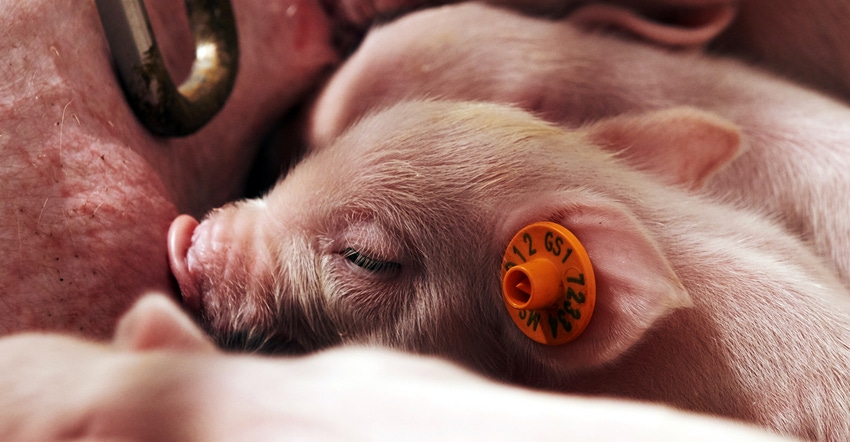Precision Technology's Role in R&D
Capturing individual pig data opens new avenues for research, helping producers make smarter, data-driven decisions.
April 1, 2021

Sponsored Content
By Dr. Greg Krahn, Manager of Research Operations, United Animal Health
This is Part 2 of a 3-part series. Read Part 1 here.
How does UAH use precision technology in research and innovation?
At United Animal Health, we implement technologies in research trials that capture individual pig performance data. This data opens the door to a deeper understanding of factors that is not attainable through traditional research methods. In all of our research trials, we have a strong focus on collecting individual pig information which gathers distinct results, gains a deeper understanding into production metrics and delivers insights to help producers make data-driven decisions. Using precision technology removes most manual data entry and reduces errors, missing data, double entry and improves research trial analysis and interpretation.
What precision technology systems is UAH using today within its research facilities and with customers?
United Animal Health’s utilizes the LeeO Individual Animal Identification System and Big Dutchman feed system for routine collection of precise, individualized data that is not commonly found across the swine industry. LeeO is a precision livestock farming system that uses Radio-Frequency Identification (RFID) technology to track individual animal performance throughout the pig’s entire lifespan. Ultra-High Frequency (UHF) RFID tags are applied to all pigs within 24 hours of birth. The RFID tags are then scanned with the use of a UHF reader, recording the identity of the pig and associating the pig with daily on farm activities in the LeeO mobile application. This process is a high-level approach to recording litter information, mortalities, pig movements, inseminations, and weights and provides real-time access to data recorded in LeeO. The Big Dutchman Feed System is used in finishers to measure pen feed intake and in farrowing rooms to measure individual sow lactation feed intake. The use of these technologies creates more a precise, consistent, and efficient data collection process which is generated with greater volume, variety, and velocity than in the past. Accurate collection of research trial data is critical, but precision technology provides more confidence and validity with the information collected. Leveraging the capabilities of LeeO technology and UAH’s research farms, big data analytics are used to investigate the effects of body weight impact on lifetime performance.
Specific to sow research, how is United using precision technology?
The success of the pig starts with the sow and UAH is committed to understanding what we can do from a production or nutritional standpoint to set that pig up for success. Due to the large capital investment and number of animals needed to pick up treatment differences, sow research is not commonly executed in the industry. UAH is committed to quality research that backs our products and this vision started with John Swisher, the founder of United, when he built the first research farm 50 years ago.
Through our internal research farms and precision technology systems, we have the ability to conduct gilt development, breeding, gestation and lactation research at a very high level of accuracy. Body weights are routinely recorded at the sow farm to understand how gilt development and changes in sow body weight influence sow lifetime performance. The unique combination of using information gathered with LeeO and the Big Dutchman System, leads to understanding the importance of lactation feed intake on lactation performance. Analysis of data captured at UAH’s Research Farms further confirms the importance of identifying appropriate strategies to drive sow lactation feed intake, resulting in improved sow reproductive fitness and downstream progeny performance.
What information is this providing beyond traditional research efforts?
Capturing individual pig data opens new avenues for research which can identify, quantify, and correlate factors influencing efficiencies in swine production systems and provides greater visibility into individual animal performance. Population variation in pork production systems can result in significant economic loses. Measuring variation in a population of pigs is theoretically very simple, but not attainable through traditional research efforts, such as measuring pen weights. Individual pig data provides an opportunity to evaluate variation within a population and investigate factors influencing variation. The ability “double-click” on a sub-population within a herd can lead to determining appropriate strategies to reduce variation and help producer’s profitability. And, having the ability to track individual pig performance back to the sow allows for an even greater understanding of factors associated with the sow’s impact on overall system profitability.
Using these technologies provides an abundance of data and an increased opportunity to analyze comprehensive data sets without sacrificing the goals of traditional research trials. The big data research process begins with an investigation of available data, rather than the belief that new, researcher-generated data is necessary. With UAH’s commitment of collecting individual pig data on every research trial, this allows for retrospective analysis on measures taken throughout the pig’s lifespan. The goal of theory-informed big data research is to provide insights and outcomes that are leveraged from the abundance of data to help producers make data-driven decisions.
How do you expect producers will use precision technology in the future of pork production?
Other industries in agriculture, such as agronomy, were early adopters and have fully embraced the benefits of precision technology by using GPS, soil sampling, yield monitors and variable rate technology to give farmers the ability to more effectively use crop inputs. Precision technology in pork production is a management tool for continuous monitoring of herds by collecting large amounts of detailed data in a short period of time. Depending on what parameters you measure, real-time analysis allows for detection of trends and prediction of adverse events that impact system wide production. Through tracking and verification, improvements in swine welfare can be made and will meet future pork production stakeholders and consumer expectations. Development and implementation of these technologies improves the transparency and overall sustainable future of animal agriculture.
About the Author(s)
You May Also Like



